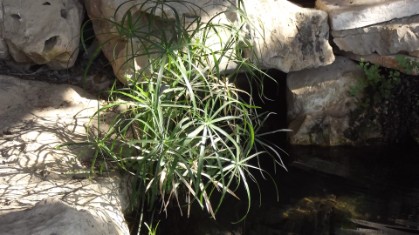Plant Photos and ID Gallery; including specific data
Specific Plants Mentioned in the Bible
The following specific plants are mentioned in the Bible. This listing is keyed to the NKJV, but variant names from five additional popular translations—KJV, NASB, REB, NIV, and NRSV—are cross-referenced throughout the listing.
Both their common and scientific names are given along with photos.
Pronunciation Guide of botanical Latin names
Acacia. (Acacia tortilis and other species)
A large thorny tree with rough gnarled bark. The orange-brown wood was hard-grained, and it repelled insects. It bore long locust-like pods with seeds inside and produced round, fragrant clusters of yellow blossoms. Many species of acacia grew in the
Acacia wood was used to build the ark of the covenant and the first tabernacle (Ex. 36:20; 37:1). The acacia is called shittim and shittah in the KJV (Ex. 25:5, 10; Is. 41:19).
Algum, Almug. (Juniperus excelsa)
A large leguminous tree native to India and Ceylon. Algum blossoms were pea-like, and its wood was close grained, dark outside, and red inside. It was highly scented, making it resistant to insects.
The Book of Kings (I Kings 10:11-12)
calls this wood algum and says it was imported from Ophir, while the Book of Chronicles (2 Chr
2:8; 9:10-11) may calls it almug and says it came from Lebanon. Since
the books were written by different authors from politically divergent areas of
ancient Israel, there is no telling which is more reliable.
According to the Bible, the algum or almug tree was used by Solomon to build pillars for the Temple and for musical instruments (I Kings 10:11-12).
While its identity is uncertain, it is believed by some scholars, including the ancient rabbis, to be the red sandalwood. But there is much argument - while one source suggests that red sandalwood is not suited for making instruments such as harps, another source insists that it is still used in the Middle East for musical instruments. Possibly the algum was not a specific tree but a quality or variety of tree, or perhaps it was another word for ebony (see below).
Almond. (Amygdalus communis)
A large tree resembling the peach tree in both size and fruit. The almond was chiefly valued for the nuts it produced, which were used for making oil used in the home and as medicine. The Hebrew word for almond means “awakening,” an allusion to the almond blossom, which is first to bloom in the spring. The almond's pinkish-white blossoms always appear before its leaves.?
The almond played an important role in the history of ?Israel. Jacob included almond nuts in his gifts to Joseph in Egypt (Gen. 43:11). The decorations on the lampstands were modeled after the almond blossom (Ex. 25:33), and Aaron's rod was an almond twig (Num. 17:8). The almond also symbolized the dependability of God (Jer. 1:11–12). Many scholars think the hazel of Genesis 30:37 (KJV) is the almond tree.
Other possible species ID - Prunus dulcis - (see J. Paterson)
More data:
There are at least three wild species of almond tree in Israel. Come the midwinter festival of Tu B'Shvat, the Jewish New Year for trees, their blossoms adorn rural hillsides and town gardens alike, dotting the landscape with pink-white puffs. Israel is believed to be one of the regions where the tree was domesticated and indeed almonds are still grown commercially here to this day.
Almond Tree: Sheked ("to hasten") in Hebrew, the almond tree blossoms before it bears leaves. It is the first tree in Israel to blossom , with the fruit edible in two stages. The green pods, while still tender, are very tasty; the better-known nuts come later.
Because of confusion in Hebrew terminology and the common mistake of identifying biblical trees with those in Europe, trees are sometimes mis-named in the Bible. An example is "And Jacob took him rods of green poplar, and of the hazel and the chestnut tree" (Gen 30:37). The more accurate translation reads: "And Jacob took him rods of green poplar, and of the almond and plane tree."
When a rebellion broke out in the desert during the wandering of the children of Israel, an almond branch became the factor that decided which tribe should rule in the sanctuary. Each tribe's leader carved his name in a rod made from the almond tree, and all twelve rods were placed in the Tabernacle.
On the following day, it was found that only Aaron's rod bore fruit: " ... the rod of Aaron for the house of Levi was budded, and brought forth buds, and bloomed blossoms, and yielded almonds" (Num 17:1-10).
The shape of the bowls for the menorah in Jerusalem was copied from the almond blossoms ("bowls made like unto almonds, with a knop and a flower" [Ex 25:33]). The almond is held in such high esteem that a mishnaic story includes it among the ten things created on the eve of the Sabbath, another of which is the rod of Moses.
Almug (see Algum, Almug).
Two flora, one a tree and the other a plant (Aloe vera).
1. The aloes mentioned in Psalm 45:8, Proverbs 7:17, and Song of Solomon 4:14 came from a large tree known as “eaglewood,” a plant native to India. The wood of the aloe tree is fragrant and highly valued for perfume and incense. Many authorities believe the lign aloe to be the same tree (Num. 24:6, KJV).
The documenting of biblical plants and aromatics down through the ages has been inexact. The first entire book on plants was not published until 1566 by Levinus Lemmens. Many botanists believe that aloes was derived from sandalwood, one of the oldest incenses known to man. Its 4,000-year history includes use as a carved wood as well as distillation for its sweet, woody, and fruity-scented oil. The great antiquity of myrrh and aloes used in preparing Christ’s body for burial was indicative of respect
2. The aloes brought by Nicodemus to wrap the body of Jesus (John 19:39) were probably the true aloes of the lily family. The aloin derived from the pulp of the aloe leaf was an expensive product used in embalming.
More Data:
Aloe: The perfume of the aloe was a luxury in biblical days. Since it was not native to Israel the Bible mentions it as in import from, or as known from travels to, another land. Balaam, who came from a town near the Euphrates where the aloe undoubtedly grew, was supposed to have cursed Israel. Instead he pronounced a blessing, making use of the image of the aloe: "As the valleys are they spread forth, as gardens by the river's side, as the trees of lign aloes which the Lord hath planted" (Num 24:6).
Its pleasant scent made aloe a valuable ingredient, along with myrrh, in an embalming mixture, and Nicodemus brought a hundred-pound weight of myrrh and aloes to Jesus' body. Jesus was wound in linen cloths with the spices (John 19:39). The same mixture of aloe and myrrh, but with cinnamon added, was used by whores to perfume their beds (Prov 7:17), and the psalmist sings of the king's garments scented with myrrh, aloes, and cassia (Psa 45:8.). The perfume, extracted from the tubular leaves rather than from the decorative red flowers, was valued throughout the ancient world.
A large family of plants that includes weeds and garden plants. Goodspeed translates the amaranth, also called the “rolling thing,” of Isaiah 7:13 as the tumbleweed. It is also called the “resurrection plant” and the “rose of Jericho.” The Greek word for amaranth means “unfading.” This meaning is used symbolically in 1 Peter 1:4 and 5:4, where the inheritance of the faithful is described as unfading. Thus, the amaranth became a symbol of immortality.
Anise. (Anethum graveolens)
An annual herb that bears yellow flowers and fragrant seeds. The anise mentioned in the Bible is generally thought to be dill. Anise (dill) was used as medicine and for cooking.
Jesus used the anise as an illustration when He scolded the Pharisees for keeping part of the law in detail while ignoring the rest (Matt. 23:23; also Deut. 14:22).
Apple. (Pyrus malus)ljm (Malus communis)sps
A tree that grows about 9 meters (30 feet) high and has rough bark and pink blossoms. Many authorities believe the apple of Scripture actually is the apricot, a native of
The apple was described as sweet and fragrant (Song 7:8; REB), golden (Prov. 25:11), and suitable for shade (Song 2:3). This fruit was used figuratively to show how precious we are to God, and how extremely sensitive He is to our needs. The phrase “apple of (the Lord's) eye” (Deut. 32:10; Ps. 17:8; Zech. 2:8) refers to the pupil of the eye, which is its most precious part.
Aspen (see Mulberry).
Balsam. (Cistus incanus and perhaps other species of Cistus)
A thorny tree growing 3 to 5 meters (10–15 feet) tall with clusters of green flowers, also known as the
Balsam was highly valued during Bible times (Gen. 37:25; 43:11; Jer. 8:22; 46:11; 51:8; Ezek. 27:17). It produced a fragrant, resinous gum called balm.
This was an article of export (Gen. 37:25) and was given as a gift by Jacob (Gen. 43:11). Balm was used as a symbol in Jeremiah 8:22 to refer to spiritual healing.
Barley. (Hordeum vulgare)
A grain known since early times. It was well adapted to varied climates, ripening quickly and resistant to heat; it usually was harvested before wheat. Because barley was considered a food for slaves and the very poor, however, it was held in low esteem as a grain.
In the Bible barley was first associated with
Bay Tree. The laurel, a tree native to
Bean or Fava / Faba (Vicia fava)
A hardy plant about one meter (three feet) tall with pea-shaped fragrant blooms, large pods, and black or brown beans, which were eaten alone or cooked with meat. Beans have always been an important part of the Hebrew diet, especially among the poor, and they have been known since ancient times. When beans were threshed and cleaned, they were often mixed with grains for bread (Ezek. 4:9).
Bitter Weed (see Wormwood).
Black Cummin (see Cummin; Fitches).
Box Tree. A tree of very hard wood and glossy leaves, which grew to a height of about 6 meters (20 feet). A native of northern Canaan and the Lebanon mountains, the box tree was well-suited to beautify the
Some scholars have suggested that the box tree of Scripture may instead be the cypress or plane. Also see Chestnut.
Bramble (see Thistles/Thorns).
Brier (see Thistles/Thorns).
Broom. (Retama raetum)
A dense, twiggy bush, almost leafless, which grew to about 3.6 meters (12 feet). It has small white blooms. Common in the desert regions of
The long roots of the broom tree enable it to reach ground water even in the driest months (1 Kin. 19:4).
Calamus. (Acorus calamus)
A fragrant, reed-like grass growing along streams and river banks (Song 4:14), also referred to as sweet cane (Is. 43:24; Jer. 6:20). Calamus leaves are fragrant and ginger-flavored when crushed. It is named with other aromatic substances (Ezek. 27:19) and as one ingredient for the anointing oil (Ex. 30:23). It is believed to be a plant native to
Camel-thorn (see Cypress).
Caperberry. (Capparis spinosa)
A plant with large white, berry-producing flowers, which grows in clefts of rocks and on walls. Only the REB and NASB refer to the caper. Other versions translate the Hebrew word as “desire” (Eccl. 12:5). Also see Hyssop.?
Articles :
http://israeltours.wordpress.com/2013/06/19/flowers-of-israel-caper/
Carob or St. John's bread (Ceratonia siliqua L.)
Photo by Rachel Leah Bez, Jericho, 2011.
Cassia. cinnamon (Cinnamomum aromaticum, C. zeylandica)
A plant with a flavor and aroma similar to cinnamon, but considered inferior. Some believe it could be the Indian perfume called orris. Moses included cassia in the anointing oil (Ex. 30:24). It was also an article of trade (Ezek. 27:19).
Two of the oldest known spices in the world are cinnamon and cassia. While cassia is similar to cinnamon, it has a more pungent, less delicate aroma. It was an ingredient in the holy anointing oil and the incense that was burned daily in the temple. Cassia oil is distilled from the plant's leaves and twigs. In Job 42:14, Job bestowed the name Kezia(Hebrew for Cassia) on one of his three daughters. Cassia oil is among the most antiseptic of essential oils.
Cattail. (Typha domingensis)?
Cedar. (Cedrus libani)
An evergreen tree that sometimes grows more than 30 meters (100 feet) tall with a trunk circumference of 12 to 15 meters (40–50 feet). It grows in western Asia, the Himalayas, and
The cedar's fragrant wood was rot-resistant and knot-free, making it ideal for building purposes (2 Sam. 5:11; 1 Kin. 6:9), shipbuilding (Ezek. 27:5), and fashioning idols (Is. 44:14). The reference to cedar in Leviticus 14:4 and Numbers 19:6 is generally understood to be the juniper which grew in the Sinai. Also see Fir; Pine.
Once plentiful in the mountains of
Chestnut. A tree of
Cinnamon. A member of the laurel family, the cinnamon tree grew to be more than 9 meters (30 feet) tall with white flowers and wide-spreading branches. A native of
Citron or Etrog, even Hadar tree (Citrus medica L).
"And you shall take on the 1-st day the fruit of beautiful trees, branches of palm trees and boughs of leafy trees and willows of the brook, and you shall rejoice before the Lord your God 7 days!" Leviticus 23:40.
Its origin is unknown, maybe Iran or Southern Arabia, but it was identified with the biblical plant "beautiful/goodly trees", which is among the four kinds that are traditionally use to construct both a lulav and sukkah during Sukkoth. The etrog has became a symbol in Jewish art since the days of the Mishnah.
Coriander. (Coriandrum sativum)
An annual herb, growing from one-half to one meter (two to three feet) tall, which produced grayish seeds used to flavor foods, for confections, and in medicine. The dried leaves of coriander were also used to flavor foods.
Cotton. (Gossypium sp.)
Cummin. (Cuminum cyminum)
A tall evergreen tree of hard and durable wood.
Daffodil (see Narcissus)
Dove Droppings/Dove's Dung. (Ornithalagum umbellatum?), or perhaps Muscari commutatum or the seeds of Ceratonia siliqua)
A bulbous plant which was edible after being boiled or roasted. Dove's dung was mentioned as food eaten during the siege of
Ebony. (Diospyros ebenum)
A large tree that produces edible fruit. The hard, black wood from the inner portion of the tree is quite valuable and is used for fine furniture. It is also known to have been inlaid with ivory. Idols were sometimes carved from ebony.
Fig. (Ficus carica)
A fruit-producing plant that could be either a tall tree or a low-spreading shrub. The size of the tree depended on its location and soil. The blooms of the fig tree always appear before the leaves in spring. When Jesus saw leaves on a fig tree, He expected the fruit (Mark 11:12–14, 20–21). There were usually two crops of figs a year.
Figs were eaten fresh (2 Kin. 18:31), pressed into cakes (1 Sam. 25:18), and used as a poultice (Is. 38:21). Jeremiah used the fig tree as a symbol of desolation (Jer. 8:13). It also signified security and hope for Adam and Eve (Gen. 3:7), the 12 spies (Num. 13:23), and the poets and prophets. Sycamore figs were similar to the fig but were smaller and of poorer quality (Amos 7:14). They were eaten by poor people who could not afford the better variety.
A fig tree loaded with its small green fruit. Jesus pronounced a curse on a fig tree because of its lack of fruit (Mark 11:12–14).
Go FIG-ure: a short study of biblical figs and fig trees
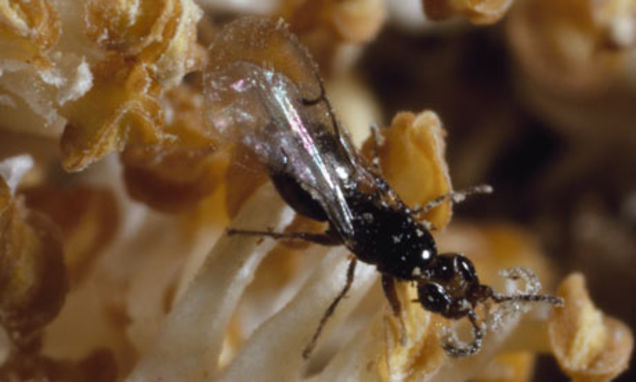
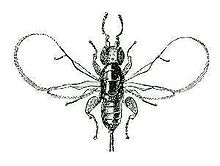
| Blastophaga psenes female | |
| Scientific classification | |
|---|---|
| Kingdom: | Animalia |
| Phylum: | Arthropoda |
| Class: | Insecta |
| Order: | Hymenoptera |
| Suborder: | Apocrita |
| Superfamily: | Chalcidoidea |
An evergreen tree of uncertain identity. Although this tree is mentioned several times in Scripture, biblical authorities question whether this was the true fir or some other evergreen of
The Israelites valued the timber of the fir tree for building the
Fitches. Two different plants mentioned in the KJV:
1. An annual herb one-half meter (one to two feet) tall with finely cut leaves and blue flowers, which produces black poppy seeds used in curries and sprinkled on breads. It is translated black cummin in the NKJV (Is. 28:25, 27).
2. A plant mislabeled by the KJV in Ezekiel 4:9. The correct identification is spelt. Also see Spelt.
Flax. (Linum ustitatissimum)
Flowers of the field (Various plants)
Frankincense. (Boswellia species)
An aromatic gum resin obtained from the Boswellia tree. These trees are large with small, white, star-shaped flowers and leaves resembling the mountain ash. The gum is obtained by cutting into the bark and collecting the resin from the tree. When this substance hardens, it is gathered and used as incense.
Frankincense was part of the sacred anointing oil (Ex. 30:34). It was used in sacrificial offering (Lev. 2:1), as a fumigant during animal sacrifices (Ex. 30:7), and as perfume (Song 3:6). It was a gift to the baby Jesus (Matt. 2:11).
The trees are native to India, Arabia, and Africa. Palestine probably obtained this product through foreign trade. “The dromedaries of Midian and Ephah; all those from Sheba shall come” (Is. 60:6).
Other species ID - Boswellia carterii - (see J. Paterson)
Frankincense as a medicinal treatment
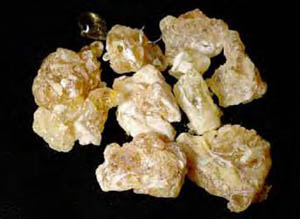
Were the gifts of the magi meant to saveJesus from the pain of arthritis? It’s possible, according to researchers at Cardiff University in Wales who have been studying the medical uses of frankincense.
Gall. (Conium maculatum or Papaver somniferum?)
A bitter, poisonous herb. This may have been the poppy or some other wild poisonous plant. Gall is used figuratively to mean a bitter punishment (Jer. 8:14; 9:15; 23:15) or any bitter experience (Acts 8:23). Gall and vinegar were offered to Jesus on the cross (Matt. 27:34), but He refused the drink.
Garlic. (Allium sativum)
A strong-flavored herb, resembling the onion. Garlic was eaten with bread and used to flavor food and is still highly favored today. Garlic was highly esteemed in
Gopherwood (see Cypress).
Gourd. (Citrullus colycinthus)
A fast-growing shrub that grew to a height of three to four meters (10–12 feet). One of Elisha's servants put the fruit of the gourd into a pot of stew (2 Kin. 4:39).
The gourd (Jon. 4:6–10; KJV, REB; vine, NIV) is identified as the plant under which Jonah found shade. Some biblical scholars suggest this may have been pumpkin, squash, or ivy.
Many types of wild gourds also flourished in the Mediterranean region. Some of these were poisonous. The decorations used on the
Grapes. (Vitis vinifera L)
A luscious fruit cultivated on vines. Large clusters of grapes weighing about five kilograms (12 pounds) each (Num. 13:23) have been reported in
Grapes were used in a variety of ways. They were eaten fresh or dried and were made into wine or vinegar. Dried grapes were called raisins. The first suggestion of grapes in Scripture was in connection with Noah's vineyard (Gen. 9:20).
The soil and climate of
Vineyards were hedged or fenced as protection from wild animals (Song 2:15). In each vineyard a tower was erected and a guard placed to protect the vines from robbers (Matt. 21:33).
Vinedressers were hired to care for the vines and prune them yearly (Lev. 25:3; Is. 61:5). The grapes were gathered in baskets in September and October with much festivity (Judg. 9:27; Is. 16:10). Provision was made for the poor to glean the fields (Lev. 19:10; Deut. 24:21). The choicest grapes were dried or eaten fresh and the rest were placed in presses to extract the juice (Is. 61:5; Hos. 9:2–4). This was drunk fresh or fermented.
Jesus alluded to His relationship with His followers by referring to Himself as the vine and to them as the branches (John 15:5). The fruit of the vine symbolized Jesus’ shed blood (Matt. 26:27–29). He also used the vineyard in many of His parables (Matt. 9:17; 20:1–6; 21:28–32; Luke 13:6–9).
Photo below right by Rachel Leah Bez, Yad Hashmona, Israel. November 2011
Gum resin. (Pistacia palaestina?)
Gum tragacanth. (Astragalus gummifer?)
Hazel.
Henna. (Lawsonia inermis)
A plant used to produce a valuable orange-red dye. It was two to three meters (seven to ten feet) tall and bore fragrant white flowers. Solomon compared his beloved to a cluster of henna (Song 1:14; 4:13; camphire, KJV).?
Articles:
http://ferrelljenkins.wordpress.com/2013/02/12/like-a-cluster-of-henna/
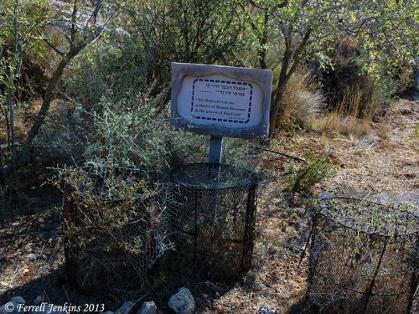
Hyssop. (Origanum syriacum)
A species of marjoram and a member of the mint family. Hyssop was an aromatic shrub under one meter (three feet) tall with clusters of yellow flowers. It grew in rocky crevices and was cultivated on terraced walls. “From the cedar tree of
Ladanum (Cistus incanus) (See Balm of Gilead).
Lavendar (Lavender lavandula stoechas L.)
photo by Ed Bez, Yad Hashmona, Israel. November 2011
Lentil. (Lens culinaris)
A small annual plant with white, violet-striped flowers. The seeds of lentils grew in pods similar to the pea. During Bible times lentil was threshed like wheat and boiled into a reddish-brown pottage. This was the dish Esau purchased with his birthright (Gen. 25:34). Lentils could also be used as an ingredient for bread (Ezek. 4:9).
More:
Lily of the field (Anemone coronaria?)
Lily of the valley (Various)
A flower with white or rosy-purple blooms measuring up to 30 centimeters (12 inches) across. Many scholars think the lily is sometimes a term applied to flowers in general. Others believe specific types such as the Turks Cap, the Madonna, or the lotus is referred to.
The lily was used as an ornament for the
The lotus, a type of water lily, was the symbol of
White lily - Lilium candidum - (see J. Paterson)
Locust. An evergreen tree growing about 6 to 9 meters (20–30 feet) tall and having small glossy leaves. A native of
Mallow. A shrub growing one and one-half to three meters (five to ten feet) high and having thick, succulent leaves and small purple flowers. The Hebrew word for mallow means “salt plant.” It thrived in dry, salty regions especially around the
Mentioned only once in the Bible (Job 30:4), mallow is also translated as salt herbs in the NIV and saltwort in the REB.
Mandrake. (Mandragora autumnalis)
A fruit-producing plant with dark green leaves and small bluish-purple flowers. The mandrake grew abundantly throughout ?Palestine and the Mediterranean region.?
The yellow fruit of the mandrake was small, sweet-tasting, and fragrant. It had narcotic qualities and may have been used medicinally. The fruit of the mandrake was also referred to as the “love apple.” It was considered a love potion (Gen. 30:16).
Internet sources:
http://israel-tourguide.info/2013/07/03/flowers-of-israel-mandrake/
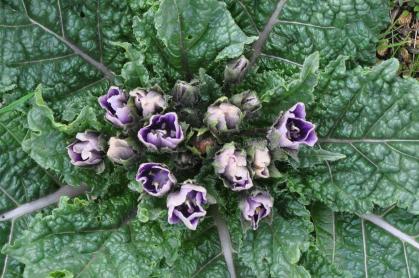
Right hand Photo - blooming Mandrake courtesy of Shmuel Browns
Melon. (Citrullus lanatus)
A type of gourd that bears sweet fruit. Both cantaloupes and watermelons may have grown along the banks of the
The Hebrews had become accustomed to eating melons and other tasty foods in
Millet. (Sorghum vulgare) See sorghum
An annual grain-producing grass that was under one meter (three feet) high and produced many seeds. The seeds of millet were smaller than other cereal grains. Millet has been known since ancient times in ?Palestine and Egypt. It was used for bread (Ezek. 4:9) and eaten raw, especially by the poor.?
Millet is referred to in several different ways in Ezekiel 27:17 (pannag, KJV; confections, NIV; meal, REB, cakes, NASB).
Articles about Millet
"Food for Rome: An analysis of the diet of common people in suburban Rome in the Imperial period (1st–3rd centuries AD) reveals a high consumption of millet".
Mint. (Mentha longifolia)
A sweet-smelling herb that grew to a height of one meter (three feet) and produced spikes of lilac flowers. Mint was used in medicine and to flavor foods.
Mulberry. A tree that grew to a height of about eight to ten meters (25–30 feet) and produced red berries. A refreshing drink was prepared from the fruit. Jesus used the mulberry tree as an illustration when teaching about faith (Luke 17:6). It is called sycamine in the KJV and NRSV, and mulberry in the REB. The mulberry trees mentioned in 2 Samuel 5:23–24 and 1 Chronicles 14:14–15 are believed to be a species of poplar.
Mustard. (Brassica nigra or B. alba)
A plant that grew wild along roadsides and in fields, reaching a height of about 4.6 meters (15 feet). The black mustard of
The mustard seed was the smallest seed known in Jesus’ day (Matt. 13:32). Nevertheless, Jesus said that if one has faith like a mustard seed, he can move mountains (Matt. 17:20) or transplant a mulberry tree in the sea (Luke 17:6).
Mustard seeds video.
Myrrh. (Commiphora gileadensis) and other species.
An extract from a stiff-branched tree with white flowers and plum-like fruit. After myrrh was extracted from the wood, it soon hardened and was valued as an article of trade. It was an ingredient used in anointing oil (Ex. 30:23), and was used as perfume (Ps. 45:8; Prov. 7:17; Song 3:6), in purification rites for women (Esth. 2:12), as a gift for the infant Jesus (Matt. 2:11), and in embalming (John 19:39). According to the Gospel of Mark (15:23), the drink offered to Jesus before His crucifixion was “wine mingled with myrrh.”
The reference to myrrh in Genesis 37:25 and 43:11 is thought to be ladanum, sometimes called onycha, from a species of rockrose and not the true myrrh.
Also see Onycha.
Other species ID - Commiphora abyssinica - (see J.Paterson)
Myrtle. (Myrtus communis)
An evergreen tree with dark glossy leaves and white flowers. The leaves, flowers, and berries of the myrtle were used for perfume and as seasoning for food. The myrtle tree had a religious significance for the Jews (Zech. 1:8–11) and was a symbol of peace and joy. Queen Esther's Hebrew name, Hadassah (Esth. 2:7), meant “myrtle.”
Narcissus ( see daffodil)
* (nar-SIS-us)
In Greek mythology, Narcissus was the beautiful son of the river god Cephissus and the nymph Liriope. Narcissus became obsessed with his own beauty and as a result, he was condemned to fall in love with himself to the exclusion of everyone and everything else. Eventually he came upon his own reflection in a pool, and he wasted away staring at his reflection. The gods then turned him into a flower.
In Victorian times, the daffodil (aka Narcissus) signified vanity and egotism. In modern times, the arrival of Narcissus signifies springtime, and a cheerful bouquet of these flowers is a delight to the senses.
* Source: http://davesgarden.com/#b
Nettle. (Urtica pilulifera)
Two different plants referred to in the Bible:
1. The nettles mentioned in Isaiah 34:13 and Hosea 9:6 are believed to be the true nettle. It is a spiny leaf plant sometimes growing to a height of about two meters (six feet).
2. The nettles referred to in Job 30:7 and Proverbs 24:31 are considered by some to be the acanthus, a stinging plant common in
The nettles of Zephaniah 2:9 (KJV) are translated weeds by the NKJV.
Oak. (Quercus calliprinos and Q. ithaburensis)
A large tree with a massive trunk that grew abundantly in
The oak tree was an important historical landmark to the Hebrews. Some specific oak trees are mentioned in the Bible. These include the oaks of Bashan (Is. 2:13; Zech. 11:2), the oak of
Oak wood was also used in shipbuilding (Ezek. 27:6), and for fashioning idols (Is. 44:14). Also see Tamarisk; Terebinth.
Oil Tree. A tree of uncertain identity. Many oil-producing trees mentioned in the Bible could be identified as the oil tree. Many authorities believe the oleaster or wild olive is the tree meant. It grew to a height of about 4.5 to 6 meters (15–20 feet) and produced small bitter fruit resembling an olive. The oleaster yielded an inferior oil that was used medicinally.
The oil tree of Isaiah 41:19 is translated the olive in the NRSV, NIV, wild olive, REB, and the olive tree in NASB. Also see Olive.
Oleander (Nerium oleander)
In the apocryphal 4th book of Ezra (9:26) the word "Ardat" is mentioned as the name of a town. This word is related to the Hebrew term for Oleander.
This beautifully flowering but poisonous plant grows along riverbeds.
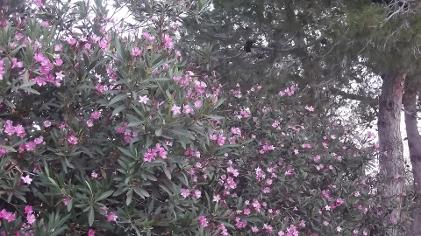
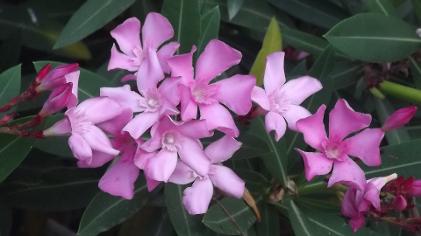
Photo by Ed Bez, Israel 2011- Yad Hashmonah
Olive. (Olea europaea)
A fruit-bearing tree about six meters (20 feet) tall with a gnarled, twisted trunk, white flowers, and berries that ripen to a black color. The olive tree grew slowly and continued to bear fruit after reaching a great age. Before it died, new branches sprouted from its roots.
The fruit was harvested by beating the boughs of the olive tree with a stick (Deut. 24:20), or by shaking the tree (Is. 17:6). The ripe fruit was enjoyed fresh, and the green fruit was often pickled or made into a relish.
The best oil was obtained from the green olive fruit. It was used as fuel for lamps (Ex. 27:20), as anointing oil (Lev. 2:1), as an article of commerce (1 Kin. 5:11), and for dressing wounds (Luke 10:34).
Olive trees were cultivated in groves or orchards (Ex. 23:11; Josh. 24:13). The most famous olive garden mentioned in the Bible is
Onycha. A dark brown gum resin obtained from the stem and leaves of a species of the rockrose, also known as ladanum. Onycha was used as an ingredient in the holy anointing oil (Ex. 30:34). It was highly valued for its fragrance and medicinal qualities.
The rockrose was a bush growing to a height of about one meter (three feet) and having large white flowers measuring eight centimeters (three inches) across. Some scholars believe the substance referred to as myrrh in Genesis 37:25 and 43:11 was onycha.
Palm. (Phoenix dactylifera)
A tree that grew to a height of about 18 to 30 meters (60–100 feet) and had long feathery leaves (branches, Neh. 8:15; John 12:13; Rev. 7:9). These branches, were about two to three meters (six to eight feet) long and grew from the top of the trunk. Also called the date palm, this tree lives to be 100 to 200 years old.
Palm branches were considered a symbol of victory (John 12:13; Rev. 7:9). Many places in the Bible were identified by the abundance of palm trees (Ex. 15:27; Deut. 34:3; Judg. 1:16).
One of the Hebrew words for palm, tamar, was often used as a woman's name (Gen. 38:6; 2 Sam. 13:1).
Palm trees in southern
Pine. (Pinus halepensis and P. pinea)
An evergreen tree of uncertain identity. Biblical scholars believe pine refers to either the Brutian or the
Bible scholars are not agreed on the identity of the many evergreens mentioned in the Bible. Other trees suggested for these references are the ash, fir, cypress, cedar, or juniper.
Pistachio Nut. (Pistacia vera)
A product of the pistacia tree, which was about nine meters (30 feet) tall with wide, spreading branches. The pistachio nut is about 2.5 centimeters (one inch) long and has a thin, hard outer shell. The smooth husk or skin that shields the green kernel is red. These nuts were sweet and considered a luxury. Jacob included them in the gifts sent to
Pomegranate. (Punica granatum)
A round, sweet fruit about ten centimeters (four inches) across with a hard rind. It is green when young and turns red when ripe. There are numerous edible seeds inside the pomegranate.
The pomegranate tree has been cultivated in
The hem of Aaron's robe was decorated with blue, purple, and red pomegranates (Ex. 28:33–34; 39:24–26). It was listed among the pleasant fruits of
A flowering pomegranate. In biblical times pomegranates were widely cultivated in
Poplar. (Populus euphratica and P. alba)
A tree that grew to a height of about 9 to 18 meters (30–60 feet) and had wide, spreading branches. The leaves were green with white undersides. Jacob stripped the bark from poplar branches to reveal the white wood. This was supposed to control the color of his cattle. “Now Jacob . . . exposed the white which was in the rods” (Gen. 30:37).
Hosea refers to the Israelites worshiping idols in the shade of poplar trees. This brought God's condemnation for their sin (Hos. 4:13). Also see Willow.
Reed/Rush. Reed (Phragmites australis) Rush (Juncus maritimus or J. arabicus)
Gigantic hollow-stemmed grasses that grew along river banks and in moist areas of
Reeds and rushes grew anywhere from one to six meters (3–20 feet) high and had long, narrow leaves. A cluster of white flowers formed at the top of each stem.
The reeds were used in various ways, including walking sticks, fishing poles, musical instruments, and pens. People also used them for weaving baskets, mats, and for other domestic purposes. Moses’ basket was woven from reeds. Papyrus, a particular reed, was used to make paper.
Reeds were a symbol of weakness (Is. 36:6). Jesus refers to them as shaking in the wind (Matt. 11:7). A reed was placed in Jesus’ hand as He was mocked by the Roman soldiers (Matt. 27:29).
Rose. Rose of Sharon (Gladiolus italicus or G. atroviolaceus?)
The name of two different plants:
1. Most authorities think that the rose referred to in Song of Solomon 2:1 and Isaiah 35:1 is not what we know as the rose today, but a low-growing bulbous plant producing from two to four yellow flowers on each stalk. This flower is noted for its fragrance. Other scholars have suggested the mountain tulip, anemone, saffron, or crocus as the flower in question. All of these flowers grew wild in
2. The rose of Ecclesiasticus 24:14; 39:13 (REB) is thought to be the oleander. This shrub grows to a height of about 3.6 meters (12 feet) and has pink or white flowers.
Rue. (Ruta chalepensis)
A garden herb growing one-half to one meter (two to three feet) high with gray-green foliage and clusters of small yellow flowers. Rue had a strong odor. It was valued for its antiseptic and disinfectant qualities. It was also used to flavor foods.
Rye (see Spelt).
Saffron. (Crocus sativus)
The product of many varieties of crocus, a flower that grew from a bulb and produced light-blue flowers.
Crocus blooms were gathered, dried, and pressed into cakes of saffron. Saffron was used as a coloring for curries and stews. It was also used as a perfume for the floors of theaters and for weddings. Solomon was the only Bible writer to refer to saffron (Song 4:14).
Shittah Tree (see Acacia).
Shittim Wood (see Acacia).
Sorghum (Sorghum vulgare)
Spelt. An inferior kind of wheat. Although the bread made from this grain was of a poorer quality than that made from wheat, spelt was preferred over barley by many in the ancient world. The KJV translates this word as rye in Exodus 9:32 and Isaiah 28:25, and as fitches in Ezekiel 4:9. Spelt was sown later than wheat. It thrived in poor soil and under adverse conditions.
Spikenard. (Nardostachys jatamansi)
A costly oil derived from the dried roots and stems of the nard, an herb of
Spikenard was imported from
Many spikes grew from a single nard root that produced clusters of pink flowers. The stems were covered with hair, giving them a woolly appearance. Some translations of the Bible refer to spikenard as nard.
Stacte. A resin believed to be an extract of the stems and branches of the storax tree. Stacte was highly prized as perfume and as incense. It was one of the ingredients of anointing oil (Ex. 30:34).
The storax was a small, stiff shrub growing to a height of about 3 to 6 meters (10–20 feet), which grew abundantly in
Straw. The dried stalks of various grains such as spelt, barley, millet, or many kinds of wheat. Straw could also include stalks of wild grasses. Straw was mixed with grain and used as fodder (Gen. 24:25; Judg. 19:19; 1 Kin. 4:28). The Egyptians mixed straw with clay for stronger bricks (Ex. 5:7).
Stone pine (Pinus pinaea)
Styrax (Styrax officinalis)
Sycamore. (Ficus sycomorus)
A huge evergreen tree growing to a height of about 12 to 15 meters (40–50 feet) with a trunk circumference of over 6.5 meters (20 feet). The trunk forked near the ground, and the branches grew outward.
The leaves of the sycamore, sometimes called the sycamore fig, were heart-shaped, resembling mulberry leaves. The fruit was similar to the true fig but was inferior in quality (Amos 7:14). These yellow figs grew in clusters close to the branches.
Sycamores were trees of the plains (1 Kin. 10:27) and could not tolerate colder climates (Ps. 78:47). The sycamore was the tree Zac-chaeus climbed to gain a better view of Jesus (Luke 19:4).
Tamarisk. (Tamarix aphylla)
A small tree with thick foliage and spikes of pink blooms. It provided ample shade for desert travelers (1 Sam. 22:6). The word for tamarisk is translated tree, grove, or oak by the KJV.
Tares. (Cephalaria syriaca or possibly Lolium temulentum)
A poisonous grass resembling wheat, but with smaller seeds. The tares were usually left in the fields until harvest time, then separated from the wheat during winnowing. Jesus used tares growing with wheat as a parable to illustrate evil in the world (Matt. 13:25–30, 36–40). Tares is translated weeds in the NRSV and NIV, and darnel in the REB.
Terebinth. (Pistacia atlantica and P. palaestina)
A large spreading tree that grew to a height of about 6 to 8 meters (20–26 feet) with reddish-green leaves and red berries in clusters. The terebinth is mentioned several times in the Bible. It is sometimes translated as teil (Is. 6:13), elm (Hos. 4:13), or oak (Gen. 35:4) by the KJV.
Thistles/Thorns. Thistles (Various species) Thorn (Sarcopoterium spinosum)
General terms for any spiny plant. Such plants are characteristic of arid and desert regions. Some of these were brambles, briers, thorny bushes, small trees, weeds, and prickly herbs. They grew abundantly in
The most noted use of thorns in the Bible was the crown of thorns placed on the head of Jesus on the cross. “When they had twisted a crown of thorns, they put it on His head” (Matt. 27:29).
Some of the thorns and thistles were annuals, scattering their seed in autumn. The industrious farmer would destroy the plants before he seeded (Matt. 13:7). Many of them were used as fuel for ovens (Ps. 58:9; Eccl. 7:6; Is. 33:12).
Thorny shrubs were used as hedges to guard fields and vineyards (Prov. 15:19; Mark 12:1). The prophet Micah declared that even the most upright person is “sharper [more destructive] than a thorn hedge” (Mic. 7:4).
Tumbleweed (Gundelia tournefortii)
Walnut (Juglans regia)
Watermelon (see Melon).
Wheat. (Triticum aestivum and T. durum)
The most important cereal grass mentioned in the Bible. It was cultivated in Bible lands from early times, “Now Reuben went in the days of wheat harvest” (Gen. 30:14). Egyptian wheat was the many-eared variety called “mummy wheat.” This was the wheat of Pharaoh's dream (Gen. 41:5–57). It was also depicted on Egyptian monuments.
Wheat was sown after barley in November or December. It was usually broadcast and then either plowed or trodden into the soil by oxen or other animals (Is. 32:20). This grain was used for bread (Ex. 29:32), and was also eaten parched (Lev. 23:14; Ruth 2:14). It was used in ceremonial offerings (Lev. 2:1; 24:5–7) and as an article of commerce (Ezek. 27:17; Acts 27:38).
When corn is mentioned in the Bible, it refers to wheat, as corn was not known in Bible times (Ps. 72:16; Matt. 12:1; Mark 4:28). Jesus compared His death to a grain of wheat that must die to produce fruit (John 12:24).
Wheat, the main field crop of biblical times, was a staple food as well as a trade item for the Israelites (1 Kin. 5:10, 11).
Other possible species ID - Triticum aestivum (see J. Paterson)
A tree that grew to about 9 to 12 meters (30–40 feet) and had reddish-brown bark; narrow, pointed leaves; and flowers or catkins that hung downward.
Some biblical scholars think the willow mentioned in the Bible was actually the poplar or
Wormwood. (Artemisia absinthium L. ,herba-alba or Papaver somniferum)
A woody shrub covered with small silver- green leaves, with greenish-yellow flowers growing in clusters. Wormwood grows in the desert regions of Palestine and Syria. This plant is mentioned many times in the Bible. It had a bitter taste and a strong aroma (Jer. 9:15).
Wormwood was used symbolically to refer to any calamity or bitter experience (Deut. 29:18; Prov. 5:4; Amos 5:7; Rev. 8:10–11). An intoxicating drink (vermouth) could also be made from this plant (Lam. 3:15). Wormwood is sometimes translated as bitter weeds or hemlock (Amos 6:12, KJV).
Wormwood tea may have been used as a remedy for labor pain in biblical times.
